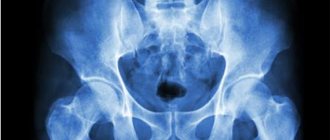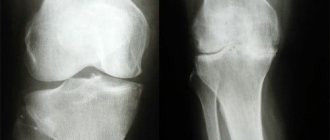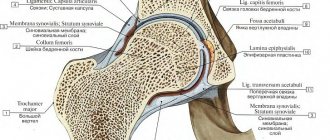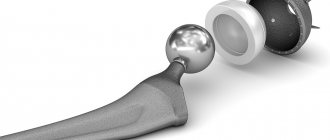Infrequent, periodic pain when walking usually goes unnoticed, especially if it goes away quickly. In fact, this seemingly insignificant symptom, like a pulling sensation in the groin area, may indicate the onset of coxarthrosis, or osteoarthritis of the hip joint. How to recognize a progressive disease in time and what to do if time is lost?
Coxarthrosis usually develops after 40 years of age
How to understand that you have coxarthrosis
The bones of the hip joint are covered with articular cartilage, which provides soft gliding and helps distribute the load while walking. The joint fluid performs a shock-absorbing and nutritional function. With the development of coxarthrosis, the characteristics of the articular or synovial fluid change - it is no longer able to sufficiently lubricate the cartilage tissue. The cartilage dries out and becomes thinner - the bones of the joint begin to rub against each other and become deformed.
At different stages these processes are accompanied by:
- pain in the groin and thigh;
- pain when walking, rising from a chair or bed;
- crunching in the joint;
- limited mobility;
- slight limp due to atrophy of the thigh muscles.
Injections into the hip joint: treatment with drugs
The choice of drug depends on the diagnosis given to the patient. During the course of treatment, the doctor may change medications, extend or stop the course ahead of schedule.
For injections into the hip joint, drugs of several groups are prescribed:
- anesthetics;
- glucocorticosteroids (hormones);
- vitamins;
- chondroprotectors;
- hyaluronic acid.
Attention! Anesthetics and vitamins are administered in combination with glucocorticosteroids.
Injections with hormones are indicated for intense inflammation, when a person suffers greatly from pain. In tablets, such drugs also have an anti-inflammatory effect, but directly at the source of pain they work much better. The most popular in this category are Celeston, Kenalog, Diprospan, Flosterone and Hydrocortisone. Anesthetics with which they are often combined are Lidocaine, Novocaine, Trimecaine. Glucocorticosteroids effectively relieve inflammation, relieve swelling and relieve pain. Hormonal injections have no effect on the condition of cartilage tissue.
What is the danger of coxarthrosis
The hip joint is subjected to enormous stress every day, so without treatment the disease progresses. If you don't take action, sooner or later:
- pain in the leg will become constant and will bother you even at night;
- posture will worsen, spinal osteochondrosis will develop;
- the diseased leg will become shorter than the healthy one;
- for walking you will need additional devices, such as a cane.
Coxarthrosis in an advanced state can lead to disability
Stages of development of coxarthrosis
The development of coxarthrosis occurs according to the same pattern as with arthrosis of the hands, knee or ankle joints:
- At the first stage, slight pain appears in the hip area, which goes away after rest. There are no problems when walking, posture and gait do not change. The image shows a slight narrowing of the joint space.
- At the second stage, the pain intensifies and reminds itself even at rest, radiating to the knee or groin area. Biomechanics are disrupted, lameness appears, and characteristic sounds are heard during movements. Due to the pelvic distortion, the affected limb is visually shortened. The pictures already show the growth of osteophytes, deformation of the femoral head and a change in its contour. The joint space narrows to a third of normal, and the head of the joint moves upward.
- In the third stage, the pain becomes constant and the person needs a cane to walk. The muscles atrophy greatly, the pelvic distortion increases, and the gait resembles a “duck’s.” The image confirms the last degree of coxarthrosis, as evidenced by many osteophytes, severe narrowing or complete absence of the joint space, and significant thickening of the femoral neck.
Coxarthrosis
Symptoms of coxarthrosis | Causes of coxarthrosis | Treatment of coxarthrosis at Doctor Ost MC
Coxarthrosis or arthrosis of the hip joint is a disease in which degenerative-dystrophic changes occur in the cartilage tissue of the hip joint. With coxarthrosis, the composition of the joint fluid changes, it becomes viscous, viscous, and ceases to nourish the cartilage. As a result, the cartilage wears out, the hip bones rub against each other when moving and gradually become deformed.
Sign up
Coxarthrosis of the hip joint is predominantly a disease of older people, although it also occurs at a young age. Osteoarthritis of the hip joint can affect one or both joints at the same time.
SYMPTOMS OF COXARTHROSIS
Signs of the disease directly depend on the stage of development. The main symptom of coxarthrosis is pain along the anterior or lateral line of the thigh. At the beginning of the development of coxarthrosis, the hip joint ache after heavy load or prolonged stress. The pain is not very bright and goes away quickly, so early-stage coxarthrosis is often left unattended.
When coxarthrosis of the 2nd degree occurs, the pain becomes severe, the symptoms of coxarthrosis become obvious. Discomfort is felt not only in the hip and pelvis area. With coxarthrosis of the 2nd degree, the pain drops lower and the knee begins to ache. Grade 2 coxarthrosis is characterized by significant deformation of the joint. Movements bring discomfort; a person subconsciously “protects” his foot, trying not to step on it. With degree 2 coxarthrosis, the gait changes, lameness appears, and the muscles of the affected leg weaken.
The most severe and dangerous 3rd degree of coxarthrosis. With stage 3 coxarthrosis, pain accompanies both day and night. And the whole leg hurts completely. With grade 3 coxarthrosis, the hip joint does not work, the muscles of the limb atrophy. At this stage, coxarthrosis quite often leads to disability. Patients with grade 3 coxarthrosis can only move with the help of a cane.
Ask a Question
Stage 3 coxarthrosis has irreversible consequences. With this form of coxarthrosis of the hip joint, surgery becomes inevitable. The deformed joint is completely replaced with a prosthesis. If surgery for coxarthrosis of the hip joint is successful and the implant takes root, joint mobility will be restored over time. But the root cause of the disease will not be eliminated, so surgery cannot be considered the definitive treatment.
CAUSES OF COXARTHROSIS
Many reasons can lead to arthrosis of the hip joint.
- The first and main reason is excessive load on the joint. This occurs in athletes and obese people. Arthrosis of the hip joint often exists in parallel with other diseases of the spine and musculoskeletal system (osteochondrosis, gonarthrosis, scoliosis, etc.).
- Disruption of metabolic processes in the body, disruption of the functioning of internal organs (in particular the kidneys) lead to problems with blood supply and nutrition to the joints. This provokes the development of coxarthrosis of the hip joint.
- Various injuries and infectious diseases are also on the list of causes of arthrosis of the hip joint. Against the background of age-related changes in the spine and joints, these causes provoke the appearance of coxarthrosis.
TREATMENT OF COXARTHROSIS OF THE HIP JOINT AT MC "DOCTOR OST"
Coxarthrosis of the hip joint does not appear in one day; this period can last several years. But every year the chances of recovery become less. After all, coxarthrosis of the joints can be effectively treated only in the first stages. With grade 3 coxarthrosis, when the hip joint is significantly damaged, it is difficult to find an alternative to prosthetic surgery. Otherwise, disability with coxarthrosis cannot be avoided.
Doctor Ost MC specializes in an innovative approach to the treatment of the spine and joints. The center has a rich arsenal of advanced techniques and has extensive experience in the treatment of coxarthrosis. Thanks to highly effective methods (high-intensity laser HILT, shock wave therapy, VTES, plasma injections, PRP therapy, etc.), they will help to quickly relieve pain and alleviate the patient’s condition, without medication.
Further treatment of joint coxarthrosis will be aimed at replenishing nutritional deficiencies in cartilage tissue, eliminating inflammation and regenerating damaged cartilage. Such an integrated approach to the treatment of joint coxarthrosis gives consistently high recovery results even in severe forms of coxarthrosis.
When determining a treatment regimen for coxarthrosis of the hip joint, the initial cause of the disease in a particular patient is determined and taken into account.
If joint deformation appears, for example, in response to excessive load due to excess weight, they will work with this factor. Doctor Ost MC presents modern hardware techniques that destroy excess fatty tissue and help even obese people lose weight safely, maintaining the weight loss results for a long time. how much does it cost? The treatment of coxarthrosis at Doctor Ost is carried out by an orthopedic traumatologist. The cost of consultation with a specialist is indicated in the “Consultative appointment” section of our price list. Follow the promotions, don't miss out on the best price!
Types of coxarthrosis
Sometimes the disease affects both joints at the same time - fortunately, this does not happen often. This form of coxarthrosis is called bilateral. Pain is felt both at rest and during physical activity. The person feels stiffness of movement, weakening of muscles, and begins to limp.
With bilateral coxartosis, “tied” legs syndrome develops
With hip dysplasia, dysplastic coxarthrosis can develop, which leads to serious deformities of the articular components. At risk are professional athletes who have given up sports, women over 25 years of age - during pregnancy, menopause, after childbirth or joint injuries. The disease can be recognized by its characteristic pain symptoms: it becomes difficult for a person to move the hip to the side or turn the leg.
Depending on the location, the prognosis for the development of coxarthrosis is different:
- If the central part of the joint is affected, the disease will most likely proceed calmly, with moderate pain. Conservative therapy in this condition gives long-lasting results.
- Also good prognosis when localized in the lower pole of the hip joint. This form of the disease is not very aggressive - the disease can slowly progress over many years.
- Coxarthrosis affecting the upper pole is the most complex, as it is accompanied by necrosis of the upper part of the head of the bone. This form occurs mainly with congenital abnormalities of the joints. The prognosis is unfavorable: in most cases, surgery is necessary.
In the treatment of coxarthrosis, the main thing is to make a timely and correct diagnosis
Treatment of coxarthrosis
The main task of treating arthrosis of the hip joint is to ensure its painless functioning.
At the initial stage, the following help slow down progression:
- radical changes in lifestyle and nutrition;
- special physical exercises;
- physiotherapy courses - ultrasound, UHF, magnetic therapy, massage, laser, etc.;
- drug therapy - analgesics (to relieve pain), chondroprotectors (to restore cartilage), in case of inflammation - non-steroidal anti-inflammatory drugs;
- warming ointments - to relieve spasms.
By losing weight, you will reduce the load on the hip joint and ease the course of coxarthrosis
Treatment of bilateral coxarthrosis of the hip joint
Bilateral coxarthrosis affects both hip joints at once; the damage is usually of varying severity. Painful and physical limitations are present in both the right and left limbs. The pain is often concentrated not only in the affected part, it radiates to the groin and knees.
With each subsequent stage, the disease progresses, thinning of the cartilage occurs, until its complete death. So, a person begins to experience more and more discomfort, even after light exertion. From the second stage, lameness and an extreme reduction in the amplitude of movements may appear, from the 3rd stage. There is usually a dependence on mobility aids such as a cane, walker, or wheelchair.
Bilateral coxarthrosis of the hip joint.
Methods of therapy:
- physiotherapeutic sessions (electrophoresis, UHF, paraffin therapy, magnetotherapy, etc.);
- Exercise therapy and local massage (exclusively after appointment by an orthopedist and only under his supervision);
- drug therapy (painkillers, vascular, anti-inflammatory, drugs from the classification of chondroprotectors and muscle relaxants, etc.);
- surgical intervention on two joints (if the form of pathology is critical).
We offer for review some tactics that, according to patients and traditional healers, can alleviate symptoms.
Gelatin treatment
Treatment of coxarthrosis with gelatin is an unconventional method, the principle of which is the local and internal use of ordinary gelatin powder. The culinary product is used for the preparation of compresses, ointments and rubs, as well as suspensions for oral administration. Since gelatin is a hydrolyzed protein and a rich source of collagen and vitamins, it nourishes cartilage, bones and ligaments that have lost strength and elasticity, and regression of degenerative changes occurs.
We recall the pictures of destroyed joints at the beginning of the article and answer the question - can gelatin help heal such damage or not?
Mud therapy
Therapeutic mud will have a productive effect in the early stages of coxarthrosis, as well as after surgery on the joint, especially after endoprosthetics. It allows you to normalize blood circulation in the weakened area, reduce pain attacks to a minimum, and generally achieve positive dynamics in restoring the motor potential of the joint. You can undergo a course of mud therapy only in sanatoriums that accept people with impaired functioning of the musculoskeletal system. It is recommended to take a mud therapy course every six months, consisting of 15-20 procedures. Sulfide-silt muds are most often prescribed. Be careful, this method has many health contraindications.
We recommend!
Laser therapy
Laser treatment has proven itself to be an effective additional treatment to the main treatment and rehabilitation program. The procedure involves the use of a laser that generates a stream of electromagnetic radiation - a light beam consisting of infrared and ultraviolet waves of various lengths. The laser beam penetrates deep into the soft tissues, warming them up, stimulating regeneration processes in the muscles and activating biochemical reactions in the joint itself. Swelling is reduced, pain is suppressed, muscle tone and water-salt metabolism in the joint are improved. Tactics give in the initial stages of pathology.
Treatment with Vitafon
Vitafon is a vibroacoustic device that has a physiotherapeutic effect. It generates vibrating microwaves, which improves tissue trophism, blood microcirculation, lymph and venous outflow, metabolism, and also stimulates reparative processes and local immunity. Vitafon is used to treat arthrosis-arthritic pathologies. Sessions can only be started after consultation with the treating orthopedist. It is prohibited to use the device during exacerbation of the disease and in the presence of active inflammation in the joint.
According to Dr. Evdokimenko
The therapy system of Dr. Evdokimenko P., who is a leading Russian rheumatologist, involves a combination of traditional medicinal methods (officially accepted) with manual and physical therapy techniques. The exercise therapy complex consists of 11 exercises that have a productive effect on restoring the biomechanics of the hip joint, which has undergone degenerative and dystrophic changes during the course of a complex disease called coxarthrosis (stage 1-2). After each session, a light massage is performed (rubbing and stroking the limbs) with the application of a warming ointment. The therapeutic course should be carried out under the close supervision of a specialist.
Doctor Evdokimenko.
How is coxarthrosis treated at the third stage?
At a late stage, conservative treatment of osteoarthritis is ineffective. Doctors recommend replacing the destroyed joint with an endoprosthesis. Unipolar - replaces only the femoral head, bipolar - the head and acetabulum. The operation is performed after a full examination and under general anesthesia, followed by antibiotic therapy and a complex course of rehabilitation measures. Repeated intervention, provided all requirements are met, the patient may need in 15-20 years.
Traditional medicine approaches the treatment of coxarthrosis as follows:
Noltrex intra-articular injections for coxarthrosis
To restore normal viscosity of synovial fluid, intra-articular injections are used today. First of all, patients are offered injections of hyaluronic acid. However, drugs based on hyaluronic acid do not have a high enough molecular weight, so they undergo rapid breakdown and do not remain in the joint for long. In addition, such products, produced on the basis of products of natural origin, often cause allergies or infectious complications.
"Noltrex" is a synthetic drug, a liquid prosthesis of synovial fluid. Its molecular weight is more than 10 million Daltons. For comparison: the molecular weight of preparations based on hyaluronic acid does not exceed 2.5 million Daltons, and on average is 1-2 million, while for natural HA in the joint this figure is 3.14 million Daltons.
That is why Noltrex does not have the side effects characteristic of hyaluronic acid, does not cause allergies and does not become a source of infection. The drug replicates the viscosity-elastic properties of synovial fluid, therefore it acts effectively. After several injections, cartilage friction stops, pain decreases, and the biomechanics of movements stabilizes. You can achieve this result even with the third stage of coxarthrosis - without surgery!
Conservative treatment
Medicines (tablets, injections and ointments)
| Nonsteroidal anti-inflammatory drugs (indomethocin, piroxicam, ketoprofen, brufen, diclofenac, movalis, etc.) are indicated during exacerbations. With long-term use, drugs in this group suppress the natural ability of articular cartilage to repair, and side effects often negatively affect various internal organs. |
| Preparations for cartilage restoration - chondroprotectors (glucosamine, rumalon, dona, structum, chondraitin sulfate, arteparone). Improves the restoration of cartilage structure, nourishes it with necessary elements. Regular use of chondroprotectors can stop the development of coxarthrosis. The positive effect is not immediately noticeable, but it will be more noticeable in the future. |
| Drugs for muscle relaxation - muscle relaxants (mydocalm, sirdalud). In case of coxarthrosis of the hip joint, treatment with muscle relaxants should be carried out with caution. They help relieve painful muscle spasms during coxarthrosis, thereby improving blood supply to the joint. Side effects: May affect the nervous system - cause dizziness, intoxication and confusion. |
| Vasodilator drugs that improve blood microcirculation (trental, nikoshpan, cynaresin, theonicol, etc.) relax the smooth muscles of blood vessels, expand their lumen, help improve articular blood supply, improve the delivery of “building materials” to the joint, and relieve spasm of small vessels. |
| Hormonal steroid drugs - intra-articular injections (diprospan, kenalog, hydrocotisone). They are used for severe pain and the ineffectiveness of NSAIDs. In some cases, such injections give good results. It is not recommended to give more than three injections in each joint. The interval between each injection should be at least one week. |
| Topical medications – ointments, lotions, compresses. The therapeutic effect is insignificant and often absent when using these drugs. |
Physiotherapy in the treatment of coxarthrosis of the hip joint
Physiotherapy includes: electrotherapy, magnetic therapy, inductothermy, UHF therapy, ultrasound therapy, the use of lasers, aeroion therapy, phototherapy. The hip joint is located deep, so it is reasonable to use physiotherapy as part of the complex treatment of coxarthrosis only to improve blood circulation and relieve spasm.
The specific procedure is chosen individually in each case - some are helped by some, others by others. Laser therapy, cryotherapy and massage provide good results for coxarthrosis.
Massage for the treatment of coxarthrosis
Massage for coxarthrosis is a very useful method. It is advisable that the massage be performed by a good specialist. Its action is aimed at improving blood circulation, strengthening muscles, relieving painful spasms, swelling and muscle tension.
If you don’t have a professional massage therapist, you can do the massage yourself. Massage for arthrosis can be performed either manually or with the help of various massage devices and even a stream of water (hydrokinesitherapy).
For grade III arthrosis of the hip joint, treatment is only surgical.









